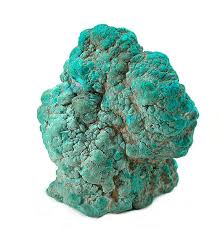The ancient Egyptians prized green turquoise very highly, naming it 'mefkat', which means 'joy' or 'delight'. In Egypt, the blue-green colour of the stone symbolised fertility and resurrection. They used it to make mosaics, ornaments and cosmetics, an it was an important stone to shamanic tribes in Tibet. Indeed, demand for turquoise has been so high throughout history that examples of cheaper imitations can be found as early as 2000BC. Despite its long history of use, turquoise was not through to be a crystal until crystalline deposits of the stone were found in Virginia, in the USE, in 1911.
Turquoise is also known as the 'Horseman's stone' due to the belief that it protected riders from falls. This also explains its attribution to the Zodiac sign Sagittarius (the centaur).
Today, turquoise is most closely associated with the native tribes of North America, who believe it to be one of the most sacred stones - representing the energy of the sky - and use it to create beautiful jewellery. In the past, many North American tribes believed turquoise gave protection to the wearer and it was widely used by medicine men, shamanic priests and tribal elders. It was said to bestow wisdom, trust, understanding and kindness on the wearer, and was often used as part of spiritual and religious ceremonies.
Protective powers
In many cultures, turquoise was believed to have powers of protection. In the Middle East it was thought to bring protection against the Evil Eye and in Medieval Europe it was claimed that turquoise could protect against snake and scorpion poisons.

In Islam, turquoise was believed to be a good protection against evil spells and it was often used to make protective amulets. This protective stone was also said to fade when its bearer was threatened with danger or illness.
Turquoise in Amerindian Myth
Turquoise is one of the few stones that can easily be found in America, and it featured heavily in local Amerindian myths. The Navajos believed that throwing a piece of turquoise into a river while praying to the Rain God would ensure the arrival of much-needed rain.
Rainbow stone

Some tribes also believed that a turquoise would be found in the damp ground at the end of a rainbow, and these stones were thought to be thunder stones, which could control the weather.
The regalia of Apache medicine men included turquoise as a talisman or badge of rank and respect. It was also thought to guide the hunter's arrows and spear to fly true. Try wearing a turquoise to gain respect and to help you to target your goals.
Healing with Turquoise
Today, turquoise is still one of the best known and appreciated gemstones. It can be difficult to find good quality turquoise and there are very good, cheaper imitations available. If you are interested in turquoise for purely decorative effect, this is of little importance. However, if you want to use it for healing, it is important you choose authentic, high quality turquoise.
This stone is thought to strengthen and align the Chakras, elevating their vibration and creating a bridge between physical and spiritual energies. This, in turn, allows access to higher levels of knowledge and intuition. However, turquoise is also thought to have a particularly close association with the Throat Chakra, improving communication of emotional issues and allowing those in its field to communicate their creativity and intuition with greater confidence.
Spiritual healers use turquoise for its protective energy as well as its ability to help with tuning into higher energies without loosing your footing on a physical level. This means that it can help you to stay grounded during meditation. It is also believed to balance masculine and feminine energies, giving clear mental and spiritual vision to any meditation.
On a physical level, turquoise is thought to emit a very strong healing vibration and has a reputation as a 'master healer' that can strengthen the body's ability to recover and protect itself. It is also believed to aid digestion. Moreover, turquoise's healing abilities are believed to extend beyond the physical. It is considered to be the healer of the spirit, protecting the seeker of truth, and a guide to the unknown. It keeps your judgement strong, ensuring independence, and is thought to be an excellent stone to take on journeys, whether they be physical, intellectual or spiritual.
Working with Turquoise
Use your turquoise to improve your fortunes, heal ailments and monitor stress levels. The stone is also the perfect gift to ensure your partner is faithful.
Improve your Luck
An old Arabian spell for improving your fortunes draws on the Jupiterian aspect of turquoise (Jupiter is the ruler of Sagittarius, and is also connected with improving your situation).
Moonlit energy
At the New Moon, place a turquoise close to a window and gaze steadily on the stone as it is bathed in the moonlight. Concentrate of your desire to improve your fortunes and then recite a simple statement of your wishes to the stone, repeating it four times.
Soothe sore throats
Turquoise has long been used to treat sore throat problems. If you suffer from frequent throat infections, try spending a few minutes each night, for one week, lying down with a piece of turquoise on your throat.
Try doing this on the waning Moon, the declining lunar energy is better suited for getting rid of things. Each night after using your turquoise, place it in a bowl of salt to remove any negativity the stone has attracted, then leave it in fresh, still mineral water. This way the stone is cleansed each day and remains ready to absorb more negative energy in the evening.
Cope with stress
Turquoise can alert you to the effects the stresses of modern life has on your body. During persistent periods of high stress, the body's copper levels rise, causing the turquoise you are wearing to change colour.
If you are living, working or studying in a stressful environment, it is a good idea to wear a turquoise close to your skin, for example, in a pendant or bracelet. The stone will change colour and act as a warning signal that you need to deal with the surrounding stress before your health suffers.

A Gift for your Partner
In many cultures, turquoise has been a traditional gift between lovers. An Oriental proverb says of turquoise that 'given by a loving hand, it brings with it happiness and good fortune'. On a Thursday at midnight on the night of a waxing moon, give your love a piece of turquoise jewellery. At this tie, the gift is especially meaningful because you are between the fortune and benevolence of Jupiter (who rules Thursday) and the love and affection of Venus (who rules Friday).
Turquoise was also said to turn black to indicate infidelity. It was given to lovers in the past to ensure faithfulness.
